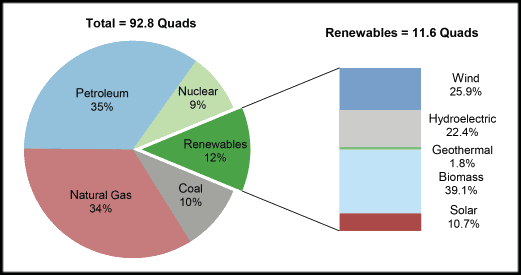While I disagree with the points regarding the “Climate Crisis,” this video is solid in it’s dealing with the fears of nuclear power safety issues and how many are frightened by misinformation. They link to two other videos that are worth a watch as well. They are:
The Truth About Nuclear Energy
How Dangerous Is Nuclear Waste?
Even environmentalists concede that nuclear power is a clean source of abundant, reliable energy. But they stop short of supporting it. Why? Because of the “waste problem.” But how real are their concerns? James Meigs, senior fellow at the Manhattan Institute, answers this question.
Nuclear Energy: Abundant, Clean, and Safe
If you truly want to save the planet from global warming, there’s one energy source that can do it. It’s not wind or solar. It’s not coal, oil or natural gas, either. So what is it? Michael Shellenberger, founder of Environmental Progress, has the answer in this important video.
The above video mentioned Will Siri, the President of the Sierra Club a few decades ago. Here is an excerpt from Michael Shellenberger’s article from FORBES (via CLIMATE DEPOT):
…In the mid-1960s, the Sierra Club supported the building of the Diablo Canyon nuclear plant to replace fossil fuels. “Nuclear power is one of the chief long-term hopes for conservation,” argued Sierra Club President Will Siri in 1966.
“Cheap energy in unlimited quantities is one of the chief factors allowing a large, rapidly growing population to set aside wildlands, open space and lands of high-scenic value,” added Siri, who was a biophysicist, mountaineer, and veteran of the Manhattan Project….
* THE BONUS BELOW WILL EXPLAIN THE FRUITION OF WILL SIRI’S POSITION – JUMP
And there is a letter the ANS is floating around as well that many are signing:
The letter: Already signed by such notables as James Hansen, Ken Caldeira, Richard Muller, Meredith Angwin, and James Hopf, the Generation Atomic letter notes that, in its early years, the Sierra Club supported nuclear technology.
“Early in the technology’s history, the Sierra Club recognized nuclear energy’s power-dense and emission-free environmental benefits,” the letter states. “Many of the Sierra Club’s members at the time were strong advocates for the energy source. Among them were Will Siri, the club’s president at the time, and the photographer and Sierra Club board member Ansel Adams.”
The Big Lie About Nuclear Waste
Nuclear waste is scary. Maybe you’ve seen it as glowing green goop in The Simpsons, or as a radioactive threat on the news. Either way, you likely know it has been a major block to the use and improvement of nuclear power. Over the last few decades, experts, politicians and the public have had heated debates over what to do with this radioactive material created by nuclear power plants.
But what if there were a way to not just store nuclear waste, but actually USE it?
This video is about the effort to make electricity out of nuclear waste. Really. It turns out, we developed the tools to do this decades ago. This story is about a technology we left behind and the people who want to bring it back.
This Environmentalist Says Only Nuclear Power Can Save Us Now
Michael Shellenberger believes The Green New Deal’s focus on wind and solar is a waste of time and money.
Calling climate change an existential threat to humanity, congressional Democrats introduced a policy proposal in February called the Green New Deal, which would mandate that 100 percent of U.S. energy production come from “clean, renewable and zero-emission energy sources” like wind and solar by the year 2050.
But some environmentalists say Green New Dealers are neglecting one obvious source of abundant clean energy already available: Nuclear power, which an accompanying Green New Deal FAQ explicitly states should be phased out alongside fossil fuels like oil, gas, and coal.
“If you want to save the natural environment, you just use nuclear. You grow more food on less land, and people live in cities. It’s not rocket science,” says Shellenberger. “The idea that people need to stay poor… that’s just a reactionary social philosophy that they then dress up as a kind of environmentalism.”
Watch the above video to learn more about the history of nuclear energy and to hear more from Shellenberger about his case for nuclear, as well as his response to concerns about radiation, nuclear weapons, and the economic viability of nuclear energy. The video also features solar energy advocate Ed Smeloff, who served on the Sacramento Municipal Utilities District board during the shutdown of California’s Rancho Seco nuclear plant and who makes the argument that nuclear power simply can’t compete in the marketplace.
PANDORA’S PROMISE:
This documentary film is about nuclear energy and other energy sources. Its central argument is that nuclear power, which still faces historical opposition from environmentalists, is a relatively safe and clean energy source which can help mitigate the serious problem of anthropogenic global warming. The film emphasize that more deaths is caused by coal powered power plants than nuclear power plants.
— PART ONE —
— PART TWO —
— PART THREE —
The below deals with the broken promises and the amount of land in the United States in order to reach a “net zero” dream. This is actually merely a combining of a few of my past posts under one umbrella.
* BONUS *
“Apocalypse Never” – Michael Shellenberger Talks With Dennis Prager
Dennis Prager had Michael Shellenberger on his show to discuss his new book entitled “Apocalypse Never: Why Environmental Alarmism Hurts Us All” (Amazon: ). In an article by Michael, you see him transitioning into a “Bjorn Lomborg” type of category. Here is the opening paragraph of that article:
- On behalf of environmentalists everywhere, I would like to formally apologize for the climate scare we created over the last 30 years. Climate change is happening. It’s just not the end of the world. It’s not even our most serious environmental problem. (ENVIRONMENTAL PROGRESS)
Facts through reason and common sense have made it through to this gentleman, and this is nice to hear. In another review of the book, it is noted that Mr. Shellenberger is a long time environmentalist and contributed “rationalism [that] is in woefully short supply in present day environmental discourse. Michael Shellenberger’s Apocalypse Never succeeds in providing a welcome boost” Here is the opening of that review:
The way to a cleaner, sustainable planet is not to eliminate fossil fuels and nuclear power, but rather to expand their use, especially in developing countries to bring economic growth and prosperity, the way such sources did for the developed world.
This is one of the primary themes in the new book, Apocalypse Never, written not by a “climate denier” or “corporate shill.” Instead, author Michael Shellenberger is a 30-year environmental activist with street cred in various causes including saving California’s redwood forests and co-founding a “progressive Democratic, labor-environment push” in 2002 for the New Apollo Project, a renewable energy initiative that long predated the Green New Deal. He also is a Time magazine “Hero of the Environment.”…..
(PA PUNDITS – Peter Murphy)
Do We Have to Destroy the Earth to Save It?
Do wind turbines and solar farms hold the keys to saving the environment? Michael Shellenberger, founder of Environmental Progress and noted climate activist, used to think so. Now he’s not so sure. He explains why in this important video. (See my previous Prager audio with Michael)
The West’s Green Delusions Empowered Putin | Shellenberger
- “It was the West’s focus on healing the planet with ‘soft energy’ renewables, and moving away from natural gas and nuclear, that allowed Putin to gain a stranglehold over Europe’s energy supply.” — Michael Shellenberger
Armstrong and Getty read some of Michael Shellenberger’s article titled, “The West’s Green Delusions Empowered Putin“. An article of similar nature is found over at THE FEDERALIST, and it is titled: “Stop Letting Environmental Groups Funded By Russia Dictate America’s Energy Policy“.
Both are must reads.
State Sized Chunks Land for a Zero-Carbon Economy
Why were federal tax subsidies extended for wind and solar by Congress? Again. For the umpteenth time! We are against subsidies because they distort markets. Those politicians who support these market-distorting policies should at least be forced to answer the question: “How much is enough?” Taxpayers have been subsidizing wind and solar corporations for more than 40 years! These companies have gotten fat and happy on your money, and Congress keeps giving them more of it. This video is based on a Texas Public Policy Foundation report that explains why it’s long past time to stop wind and solar from stuffing their bank accounts with your tax dollars.
- To give you a sense of scale, to replace the energy from one average natural gas well, which sits on about four acres of land, would require 2,500 acres of wind turbines. That is a massive amount of land. You would have to cover this entire nation with wind turbines in an attempt to replace the electricity that we generate from coal, natural gas, and nuclear power, and even that would not get the job done. (CFACT)
This is from a recent BLOOMBERG article:
At his international climate summit in April, President Joe Biden vowed to cut U.S. greenhouse gas emissions in half by 2030. The goal will require sweeping changes in the power generation, transportation and manufacturing sectors. It will also require a lot of land.
Wind farms, solar installations and other forms of clean power tend to take up more space on a per-watt basis than their fossil-fuel-burning brethren. A 200-megawatt wind farm, for instance, might require spreading turbines over 13 square miles (36 square kilometres). A natural-gas power plant with that same generating capacity could fit onto a single city block.
Achieving Biden’s goal will require aggressively building more wind and solar farms, in many cases combined with giant batteries. To fulfill his vision of an emission-free grid by 2035, the U.S. needs to increase its carbon-free capacity by at least 150%. Expanding wind and solar by 10% annually until 2030 would require a chunk of land equal to the state of South Dakota, according to Princeton University estimates and an analysis by Bloomberg News. By 2050, when Biden wants the entire economy to be carbon free, the U.S. would need up to four additional South Dakotas to develop enough clean power to run all the electric vehicles, factories and more.
Earth Day 2021 is April 22nd. Therefore, eco-activist groups will be preaching the gospel of wind & solar power and the importance of biodiversity. What those trying to “save the planet” fail to understand (or more likely ignore) is that these two priorities are in direct conflict. Wind & solar require far more land than nuclear, natural gas and coal power. They are also far more destructive to regions of high biodiversity as well as large birds, bats and endangered species. As we celebrate Earth Day, let’s consider the significant environmental consequences of attempting to provide electricity through low density, unreliable sunshine and breezes.
Vice President Joe Biden aims to be the most progressive president on the issue of climate change. The man who spent most of 2020 hiding in the basement believes the future of energy is renewable energy like wind and solar. Biden should go back to the basement, watch Michael Moore’s “Planet of the Humans,” and rethink his advocacy for renewable energy. Wind and solar are not the answer, and the idea of converting our fossil fuel-based economy into renewables could be a devastating take-down to society.
Are we heading toward an all-renewable energy future, spearheaded by wind and solar? Or are those energy sources wholly inadequate for the task? Mark Mills, Senior Fellow at the Manhattan Institute and author of The Cloud Revolution, compares the energy dream to the energy reality.
Remember when Google joined the common sense era?
FLASHBACK
We came to the conclusion that even if Google and others had led the way toward a wholesale adoption of renewable energy, that switch would not have resulted in significant reductions of carbon dioxide emissions. Trying to combat climate change exclusively with today’s renewable energy technologies simply won’t work; we need a fundamentally different approach.
[…..]
“Even if one were to electrify all of transport, industry, heating and so on, so much renewable generation and balancing/storage equipment would be needed to power it that astronomical new requirements for steel, concrete, copper, glass, carbon fibre, neodymium, shipping and haulage etc etc would appear. All these things are made using mammoth amounts of energy: far from achieving massive energy savings, which most plans for a renewables future rely on implicitly, we would wind up needing far more energy, which would mean even more vast renewables farms – and even more materials and energy to make and maintain them and so on. The scale of the building would be like nothing ever attempted by the human race.”
Google Joins the Common Sense Crew On Renewable Energies ~ Finally! (RPT)
- What It Would Really Take to Reverse Climate Change: Today’s renewable energy technologies won’t save us. So what will? (SPETRUM)
- Shocker: Top Google Engineers Say Renewable Energy ‘Simply won’t work’ (WATTS UP WITH THAT)
- Polluting the Beauty and Cleanliness Of Our World With Renewable Energy (RPT)
- Wind and Solar More Harmful To Environment Than Helpful (RPT)




